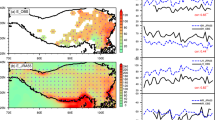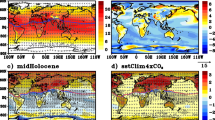Abstract
The observed South Asia High (SAH) center is characterized by two distinctive equilibrium modes during boreal midsummer, namely the center of SAH is located between 82.5°–92.5°E for the Tibetan Plateau mode and between 55°–65°E for the Iranian Plateau mode, respectively. The present study describes the ability of 15 coupled general circulation models (CGCM) used in the Intergovernmental Panel on Climate Change’s (IPCC) 4th Assessment Report to reproduce the observed bimodality of the SAH. These models reveal a wide range of skill in simulating this bimodality. Nearly half of the models reproduced the bimodality, while the other half of the models did not simulate well these two modes whereas usually preferring one mode. The models that reproduced the bimodality of the SAH present similar horizontal and vertical circulations as those features from the NCEP reanalysis data. The results from these models identify the warm characteristics of the SAH and indicate that these two modes have different dynamic and thermodynamic properties.
Different characteristics of the simulated sensible heat and latent heat related to precipitation partly contribute to the difference in the simulations of the SAH bimodality. The majority of these models that prefer to simulate the Tibetan Plateau mode produce a small sensible heat flux difference between the Iranian Plateau and the Tibetan Plateau, and also generally simulate a very strong false precipitation center over the east of the Tibetan Plateau, which indicates strong latent release and thereby contributes to the preference of the SAH center on the Tibetan Plateau. Whereas, the models that reproduce the bimodality of the SAH tend to simulate large precipitation over the southern Himalayas and no obviously false precipitation is produced over the east of the Tibetan Plateau. In addition, the model’s resolution may also have important impacts on the simulations of precipitation.
Similar content being viewed by others
References
Deque, M., and J. Piedelievre, 1995: High resolution climate simulation over Europe. Climate Dyn., 11, 321–339.
Delworth, T. L., and Coauthors, 2004: GFDL’s CM2 global coupled climate models—Part 1: Formulation and simulation characteristics. J. Climate, 19, 643–674.
Flato, G., and G. Boer, 2001: Warming asymmetry in climate change simulation. Geophys. Res. Lett., 28, 195–198.
Goosse, H., and T. Fichefet, 1999: Importance of iceocean interactions for the global ocean circulation: A model study. J. Geophys. Res., 104, 23337–23355.
Gordon, C., and Coauthors, 2000: Simulation of SST, sea ice extents and ocean heat transports in a version of the Hadley Centre coupled model without flux adjustments. Climate Dyn., 16, 147–168.
Huang, Y. and Y. F. Qian, 2003: Relationships between South Asian High and summer rainfall in North China. Plateau Meteorology, 22(6), 602–607. (in Chinese)
Huang, Y. Y., and Y. F. Qian, 2004: Relationship between South Asian High and characteristic of precipitation in mid-and lower-reaches of Yangtze River and North China. Plateau Meteorology, 23(1), 68–74. (in Chinese)
Kalnay, E., and Coauthors, 1996: The NCEP/NCAR 40-year reanalysis project. Bull. Amer. Meteor. Soc., 77, 437–471.
K-1 model developers, 2004: K-1 coupled model (MIROC) description, K-1 technical report 1. H. Hasumi and S. Emori, Eds., Center for Climate System Research, University of Tokyo, 34pp.
Kiehl, J. T., and P. R. Gent, 2004: The community climate system model, version two. J. Climate, 17, 3666–3682.
Li, Y. Q., 1996: The low-frequency oscillation over the Qinghai-Xizang Plateau and the activities of the south Asia High during the summer half year in 1981 and 1982. Plateau Meteorology, 15(3), 276–281. (in Chinese)
Li, Y. Q., 2000: Analysis of circulation variations over the Tibetan Plateau and drought-flood anomalies on its eastern side. Chinese J. Atmos. Sci., 24(4), 470–476. (in Chinese)
Mason, R. B., and C. E. Anderson, 1958: The development and decay of the 100mb summertime anticyclone over southern Asia. Mon. Wea. Rev., 91, 3–12.
Qian, Y. F., Q. Zhang, Y. H. Yao, and X. H. Zhang, 2002: Seasonal variation and heat preference of the South Asia High. Adv. Atmos. Sci., 19(5), 821–836.
Qian, Y. F., N. F. Zhou, and Y. Bi, 2004: The impacts of upper-level temperature and height anomalies on surface air temperature and precipitation in China. Plateau Meteorology, 23(4), 417–428. (in Chinese)
Roeckner, E., and Coauthors, 2003: The atmospheric general circulation model ECHAM5. Part I: Model description. Max Planck Institute for Meteorology Rept. 349, 127pp. [Available from MPI for Meteorology, Bundesstr. 53, 20146 Hamburg, Germany]
Sun, G. W., and Z. S. Song, 1987: Formation of the South Asia High and its relationship with the atmosphere circulation and rainfall belt of China. Impacts of the Tibetan Plateau on the Weather in China during Summer. Science Press, Beijing, 93–100. (in Chinese)
Sun, G. W., and B. D. Chen, 1988: The atmosphere low frequency wave and its meridinal propagation over the Tibetan Plateau. Chinese J. Atmos. Sci., 12, 250–256. (in Chinese)
Tao, S. Y., and F. K. Zhu, 1964: The variation of 100 mb circulation over South Asia in summer and its association with march and withdraw of West Pacific Subtropical High. Acta Meteorologica Sinica, 34, 385–395. (in Chinese)
Volodin, E. M., and N. A. Diansky, 2004: El-Niño reproduction in coupled general circulation model of atmosphere and ocean. Russian Meteorology and Hydrology, N12, 5–14.
Wu, G. X., J. F. Chou, Y. M. Liu, Q. Y. Zhang, and S. Q. Sun, 2000: The Dynamics of the Formation and Variation of the Subtropical Anticyclone. Science Press, Beijing, 245pp. (in Chinese)
Xie, P., and P. A. Arkin, 1996: Analyses of global monthly precipitation using gauge observations, satellite estimates, and numerical model predictions. J. Climate, 9, 840–858.
Ye, D. Z., and J. Q. Zhang, 1974: A simple simulation experiment on the impact of the Tibetan Plateau heating on the summer atmosphere circulation. Science in China, 3, 301–320. (in Chinese)
Yu, Y. Q., X. H. Zhang, and Y. F. Guo, 2004: Global coupled ocean-atmosphere general circulation models in LASG/IAP. Adv. Atmos. Sci., 21, 444–455.
Yukimoto, S., and Coauthors, 2001: The New Meteorological Research Institute Coupled GCM (MRICGCM2)—Model climate and variability. Pap. Meteor. Geophys., 51, 47–88.
Zhang, J. J., B. Z. Zhu, and F. K. Zhu, 1988: Advance in Tibetan Plateau Meteorology. Science Press, Beijing, 1–268. (in Chinese)
Zhang, Q., Y. F. Qian, and X. H. Zhang, 2000: Interannual and interdecadal variations of the South Asia High. Chinese J. Atmos. Sci., 24(1), 67–78. (in Chinese)
Zhang, Q., and G. X. Wu, 2001: The large area flood and drought over Yangtze River valley and its relation to the South Asia High. Acta Meteorological Sinica, 59(5), 569–577. (in Chinese)
Zhang, Q., G. X. Wu, and Y. F. Qian, 2002: The bimodality of the 100 hPa South Asia High and its relationship to the climate anomaly over East Asia in summer. J. Meteor. Soc. Japan, 80(4), 733–744.
Zhou, N. F., Y. Q. Yu, and Y. F. Qian, 2006: Simulation of the 100-hPa South Asia High and precipitation over East Asia with IPCC Coupled GCMs. Adv. Atmos. Sci., 23(3), 375–390. doi: 10.1007/s00376-006-0375-9.
Zhu, B. Z., and Z. S. Song, 1981: The information process of the Tibetan high and its oscillation —the observation analysis. Part 1, Collection Papers on the Tibetan Plateau Meteorological Experiments, Science Press, Beijing, 303–313. (in Chinese)
Zhu, F. K., L. H. Lu, X. J. Chen, and W. Zhao, 1980: The South Asia High. Science Press, Beijing, 95pp. (in Chinese)
Author information
Authors and Affiliations
Corresponding author
Rights and permissions
About this article
Cite this article
Zhou, N., Yu, Y. & Qian, Y. Bimodality of the South Asia High simulated by coupled models. Adv. Atmos. Sci. 26, 1226–1234 (2009). https://doi.org/10.1007/s00376-009-7219-3
Received:
Revised:
Published:
Issue Date:
DOI: https://doi.org/10.1007/s00376-009-7219-3




